The traditional town has been retreating on the American landscape for half a century as big-box retailers and big parking lots push classic storefronts toward extinction. Only a few town clusters of any size remain in the Twin Cities, notably Uptown in Minneapolis, Grand Avenue in St. Paul, 50th and France in Edina, and the business districts of Hopkins, Stillwater, Anoka, Robbinsdale and Wayzata.
None of those, however, quite matches Water Street in Excelsior for hometown flavor and authentic vibe. Maybe it's the muted color palette and the absence of neon and digital signs. Maybe it's the gradual slope that takes you past the unbroken string of shops right down to the water's edge, where you can hop a boat on Lake Minnetonka or spread a picnic in the park.
Excelsior is the Minnesota town you'd dream up if you were starting from scratch. It's neither hip nor overly cute; it's a place lost in time that's not trying to be anything other than itself.
So, when something new comes along it has to fit just right. That's the predicament facing the City Council, a predicament that most towns would die for. A vacant lot at the foot of Water Street, the most prominent spot in town, begs to be filled. A boutique hotel has been proposed, evoking a bit of the town's touristy past (although without the amusement rides and dance halls).
The issue has divided Excelsior. Some residents side with the town's Heritage Preservation Commission, which rejected the four-story hotel's size, height and design. The commission and its allies generally see the town as under assault from developers bent on ruining its charm and character. They like Excelsior pretty much the way it is. Indeed, they point to numerous examples around the metro of clumsily designed projects that have marred the beauty of historic towns.
But there's another side to the argument. Excelsior is tiny: barely 2,200 people on two-thirds of a square mile. To properly maintain its popular lakeshore, docks, commons and main street, the city must make the most of its historic charm and limited tax base. That means adding high-quality infill development and leveraging revenues from that development to improve public spaces.
A hotel is a perfect solution, as long as it fits into the historic town. This one doesn't, at least not yet.
The problem isn't height or bulk. The developer and architect have been masterful in fitting the 58-room hotel, restaurant and ballroom onto the site. Parking is hidden below ground. The building takes up only a third of the lot. Its height (35 to 55 feet) is cleverly disguised by a series of setbacks.
But developer Thomas F. James and architect Neil Weber have fallen in love with a fussy, faux-Victorian design that's a bit too Disney for straightforward Excelsior. They claim their design recalls the fancy lakeside hotels of a century ago. But those were free-standing, wooden buildings surrounded by rolling lawns, not brick structures squeezed into a classic town grid. In any case, Excelsior's ordinances require new projects to take their cues from historic buildings that still exist, not those that are gone.
The hotel is a good idea. The City Council should approve it, but only on condition that the developer work with the heritage commission to tweak the building to match its historic context. Size isn't the problem, but the current design confuses ornate detailing with authenticity. Excelsior recently insisted that a new library conform to its historic surroundings. The same should hold for this hotel.
Through compromise, the Excelsior council can teach a valuable lesson to other historic towns in the Twin Cities: You can have it both ways; you can get the density and growth you need without losing your soul. But you have to be extremely careful about design.
Protect kids online

Here's how I'd broadly frame the environment that led to my firing as a teacher
Get rid of Minnesota's precinct caucuses, go to primary elections up and down the ballot


